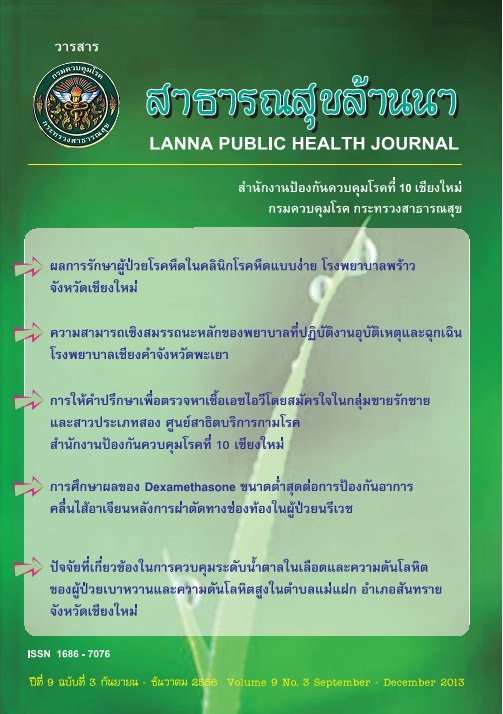การศึกษาผลของ Dexamethasone ขนาดต่ำสุดต่อการป้องกันอาการคลื่นไส้อาเจียน หลังการผ่าตัดทางช่องท้องในผู้ป่วยนรีเวช
คำสำคัญ:
PONV, Dexamethasone, Major gynecological surgeryบทคัดย่อ
อาการคลื่นไส้อาเจียนเป็นภาวะแทรกซ้อนที่เกิดขึ้นได้หลังการผ่าตัดพบได้ร้อยละ 30 ทำให้ผู้ป่วยไม่สุขสบาย ไม่พอใจการรักษาพยาบาลเกิดภาวะแทรกซ้อนอื่นๆ ตามมายา Dexamethasone เป็นยาที่มี ประสิทธิภาพในการป้องกันและการรักษาภาวะคลื่นไส้อาเจียนหลังผ่าตัด แต่ในประเทศไทยขนาดต่ำสุดที่ ใช้ยังไม่ระบุชัดเจน การศึกษานี้เป็นการศึกษาแบบ Randomized controlled trial เพื่อศึกษาขนาดต่ำสุดของ ยา Dexamethasone ต่อการป้องกันอาการคลื่นไส้อาเจียนหลังการผ่าตัดช่องท้องในผู้ป่วยนรีเวช แผนก วิสัญญีโรงพยาบาลลำพูน กลุ่มศึกษาเป็นผู้ป่วยที่มาผ่าตัดจำนวน 72 ราย สุ่มเลือกแบ่งเป็น 3 กลุ่มด้วย วิธีจับ ฉลากใส่ซองปิดผนึกโดยกลุ่มที่ 1 เป็นกลุ่มควบคุมได้รับ normal saline 2 ml. กลุ่มที่ 2 ได้รับ Dexamethasone 2 mg. (0.5ml) รวม normal saline 1.5 ml. กลุ่มที่3 ได้รับ Dexamethasone 4 mg. (1ml.) รวม normal saline 1.0 ml. ก่อนเริ่มการระงับความรู้สึกหลังการผ่าตัดสิ้นสุดควบคุมอาการปวดโดยใช้ Opioids ใน 2 ชั่วโมงแรก ประเมินอาการปวดโดยใช้ Wong-Baker FACES Pain Rating Scale ติดตาม อาการคลื่นไส้อาเจียนและการรักษาจนครบ 24 ชั่วโมง ผลการศึกษาพบว่า ลักษณะทั่วไปของผู้ป่วยทั้ง 3 กลุ่ม ไม่มีความแตกต่างกันอย่างมีนัยสำคัญทางสถิติและพบว่าขนาดต่ำสุดของยา Dexamethasone จำนวน 4 mg. มีผลลดอาการคลื่นไส้อาเจียนหลังการผ่าตัดช่องท้องในผู้ป่วยนรีเวชอย่างมีนัยสำคัญทางสถิติ (P=0.039) ข้อสรุปขนาดยาที่สามารถป้องกันอาการคลื่นไส้อาเจียนหลังการผ่าตัดช่องท้องในผู้ป่วยนรีเวช คือ Dexamethasone 4 mg.
เอกสารอ้างอิง
Apfel CC, Kranke P, Katz MH et al. Volatile anaesthetics may be the main cause of early but not delayed postoperative vomiting a randomized controlled trial of factorial design. Br J Anaesth 2002; 88:659-68.
Apfel CC, Korttila K, Abdalla M, et al. A factorial trial of six interventions for the prevention of postoperative nausea and vomiting. N Engl J Med 2004;350:2441-51.
Grief R, Laciny S, Rapf B, Hickle RS, Sessler DI. Supplemental oxygen reduces the incidence of postoperative nausea and vomiting. Anesthesiology 1999;91:1246-52.
Henzi I, Walder B, Tramer MR. Dexamethasone for the prevention of postoperative nausea and vomiting:a quantitative systematic review. Anesth Analg 2000; 90:186-94.
Lang IM. Noxious stimulation of emesis. Dig Dis Sci 1999;44 (Suppl):S58-63.
Lee A, Done ML. The use of non-pharmacologic techniques to prevent postoperative nausea and vomiting: a meta-analysis. Anesth Analg1999; 88: 1362-69.
Lee Y, Lai HY, Lin PC, Lin YS, Huang SJ, Shyr MH. A dose ranging study of dexamethasone for preventing patient controlled analgesia-related nausea and vomiting: a comparison of droperidol with saline. Anesth Analg 2004; 98: 1066-71.
Lee Y, Lin Y.S, Chen Y.H. The effect of dexamethasone upon patient controlled analgesia-related nausea vomiting. Anaesthesia 2002;57: 690-709.
Lerman J. Surgical and patient factor in volved in post-operative nausea and vomiting. British Journal of Anesthesia 1992; 69 (Suppl.1): 245-325.
Liu K, Hsu CC, Chia YY. The effective dose of dexamethasone for antiemesis after major gynaecological surgery. Anesth Analg 1999;89:1316-18.
Lopez L. Olaondo, F. Carrascosa, F. J. Pueyo, P. Monedero, N. Busto and A. Saez. Cornbination of ondansetron and dexamethasone in the prophylaxis of postoperative
nausea and vomiting. Br. J Anesth 1996;76:835-40.
Markman M, Sheidler V, Ettinger DS, et al. Antiemetic efficacy of dexamethsone: randomized, double-blind, crossover study with prochlorperazine in patients receiving cancer chemotherapy. N Engl J Med 1984; 311: 549-52.
Miller AD. Central mechanism of vomiting. Dig Dis Sci 1999; 44(Suppl): S39-43
Roberts GW, Bekker TB, Carlsen HH et al. Postoperative nausea and vomiting are strongly influenced by postoperative opioid use in a dose related manner. Anesth Analg 2005; 101:1343-48.
Rowbotham DJ. Recent advances in the non-pharnacological management of postoperative nausea and vomiting. Br J Anaesth 2005; 95: 77-81.
Rudd JA, Naylor RJ. The action of ondansetron and dexamethasone to antagonize cisplatin-induced emesis in the ferret. Eur J Pharmacol 1997; l322:79-82.
Sinclair DR, Chung F, Mezei G. Can postoperative nausea and vomiting be predicted? Anesthesiology1999; 91: 109 -18.
Stadler M, Bardiau F, Seidel L, Albert A, Boogaerts JG. Difference in risk factors for postoperative nausea and vomiting. Anesthesiology 2003; 98: 46–52.
Treschan TA, Zimmer C, Nass C, et al. Inspired oxygen fraction of 0.8 does not attenuate postoperative nausea and vomiting after strabismus surgery. Anesthesiology
2005;103:6-10.
Wang JJ, Ho ST, Tzeng JI, Tang CS. The effect of timing of dexamethasone administration to its efficacy as a prophylactic antiemetic for postoperative nausea and vomiting. Anesth Analg 2000; 91:136-9.








